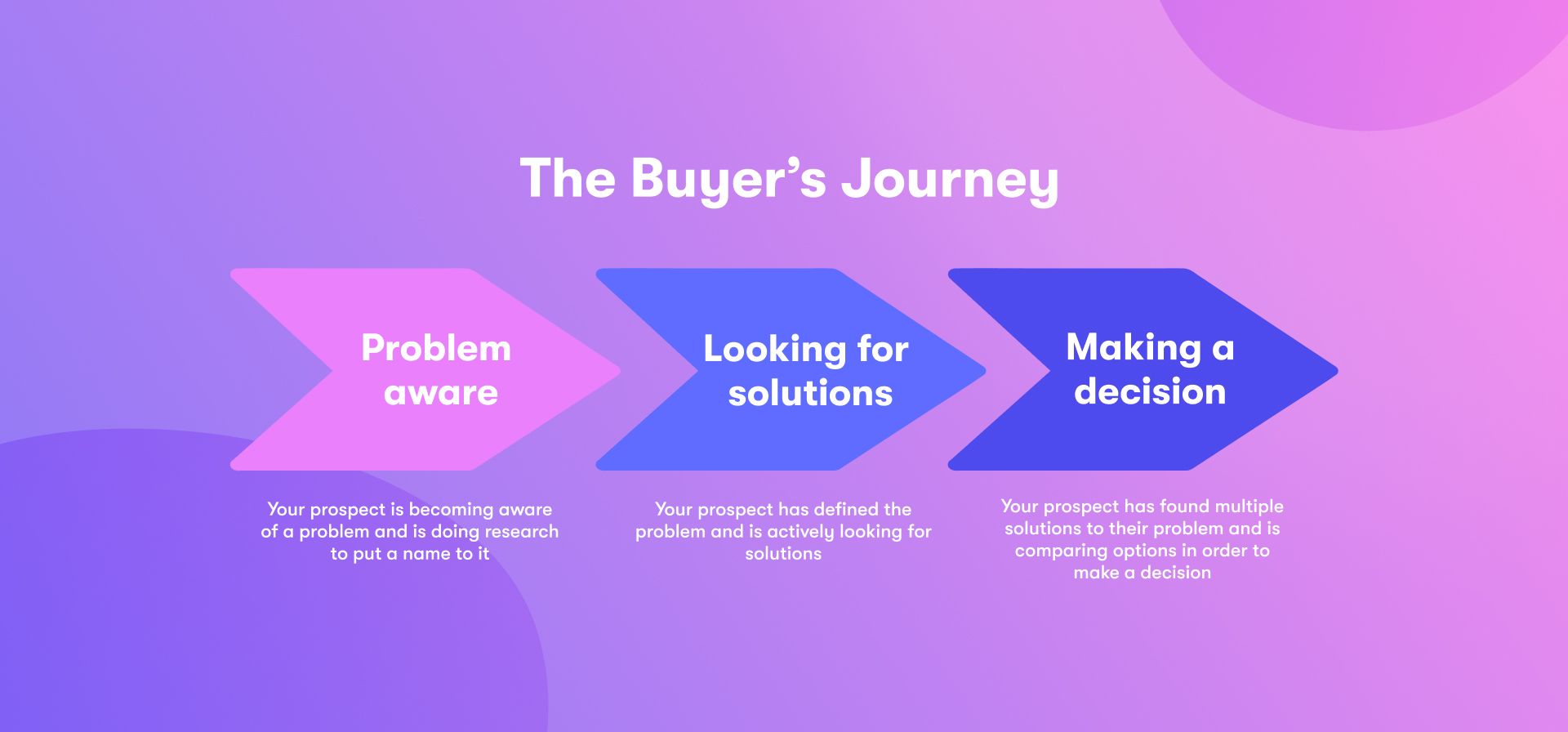How to Use a Content Map in Your Marketing Strategy

Mapping out your customer's journey
Every brand wants to deliver killer content that sticks. You can spend months perfecting an expertly crafted blog or video post. But no matter how hard you try, it's not going to resonate with every person that encounters it. You can't please them all, right?
Well, that's not exactly true. With a well-designed content map, you can deliver relevant messaging to every single one of your customers at every stage of the buyer's journey.
Want to learn how? Keep reading to discover the power of content maps and how they can help you leave a lasting impression that results in a lead. Let's go!
What is content mapping?
A content map is an outline that helps you understand how every piece of your content supports and meets customers' needs as they get closer and closer to buying one of your products or services.
You see, personalization is crucial in today's marketing world. Your intended audience is as colorful and diverse as a box of sprinkles. One static message asking them to make a purchase isn't going to cut it. While some will consider it, others aren't at that stage in the buyer's journey just yet.
The buyer's journey is a series of steps that every consumer goes through before deciding to make a purchase. The goal of content mapping is to deliver the right content at the appropriate time to guide them through their journey. There are many different approaches and varying degrees of complexity. However, the goal is always the same: Make the buying journey feel special and catered to each customer.
Content mapping in action
You might be wondering, "What is content mapping, and how does it look in the real world?
Before we get any further, let's look at some great examples of content marketing done right.
The first is one you've likely encountered many times before: Amazon! Ever wonder how Amazon always recommends relevant products? If you pay close attention, you'll start to notice a pattern of subtle suggestions and content delivery.
Amazon has one of the most complex content maps, but the core concept is the same. The platform recognizes when you show a general interest in a product category, so it slowly introduces programmatic sampling and dynamic ads to suggest a suitable product. Eventually, you'll start getting emails and custom messages that help you narrow down your search and make a decision.
It happens so so subtly, but the impact can't be understated.
Spotify, a leading music streaming platform, used a similar content map to bolster its sharing features. Spotify mapped out every experience with precise metrics to understand how listeners engaged with the app. Then, it used that information to determine when sharing could fit into the listening experience and gently provided messaging to get users to take advantage of the feature.
Now, sharing playlists and individual songs is one of the most praised features on Spotify!
Those are just two examples of what content maps can do.
Why do you need content maps?
If you're still not convinced, let's look at some of the benefits you can experience with a well-designed content map.
1. A helping hand through the sales funnel
Of course, the most obvious benefit is the opportunity to guide customers through the buyer's journey. Let's face it: Getting modern shoppers to make that final decision isn't easy. Your audience experiences a barrage of ads every single day. It might as well be background noise!
Content marketers hear it all the time, "You need to make campaigns personalized to your audience if you want it to stick."
That's not new information! The problem is knowing what kinds of information will stick and when. With a content map, you finally get that clarity. Use it to your advantage to create an effective content strategy that keeps your audience engaged to the finish line.
2. Better audience insight
Another huge perk is the ability to learn more about your audience at large. You likely already have basic information about core demographics. But what about their goals and needs?
The foundation of content mapping is in-depth data. You have to do your market research to understand what your customers want and need at every stage of the buyer's journey. Building a content map requires you to lay all of that information out.
It can unify your team, provide more insight you never knew, and help you shape your content plan.
3. Fine-tuning your content strategy
There's no better way to get the most bang out of your content buck than implementing a map. A big part of content mapping is taking a broad look at your existing pieces. Once you have your map set up, you can determine how each content plays into the buyer's journey.
You'll learn when they're most effective, ensuring that you're delivering a hefty punch every moment you can. You may see old content you thought was useless find new success at a different part of the map!
Even new content will benefit from your map. Use it to identify gaps and create brand-new pieces filled with purpose. Ultimately, you can start optimizing your strategies, leading to more success across the board.
How to create an optimized content map
Now, let's move on to the fun part! Creating a detailed content map takes time, but a few fundamental components help you piece the puzzle together.
Data-driven buyer personas
The first step of the process? It's data, of course!
You can't start your map without knowing your audience and what they want. This part of the process is one of the most time-consuming. Luckily, most successful brands already have market data for you to use.
Study it well and get to know your customers, how they shop, and more. Segment your audience to make it easier to create custom content based on the needs of different personas.
A well-documented buyer's journey
Next, you have to understand the buyer's journey. Before buying a product or service, the steps your customers go through are complex. For the sake of simplicity, we'll look at the three most common stages:

- Awareness: Your customers become aware of a problem in their life and start doing research to understand it better.
- Consideration: The problem is clear, and your audience is actively looking at possible solutions.
- Decision: Your customer knows what they want and begins comparing products before committing to a buying decision.
Those are the basic stages, but things can get more complicated than that. Detail the journey and go over your audience's experiences and needs at each chapter of their story.
Align your content map with your buyer's journey
This part of the content mapping process determines what types of content are most impactful during each stage of the buyer's journey.
For example, you know that those in the "Awareness" stage are still learning about what they have. Your customer is actively trying to put a name to it, so you can deliver educational content that nudges them your way. The "Consideration" phase is more about finding a solution. As a result, how-to guides and content that compares products might be more beneficial.
Put yourself in your audiences' shoes to figure out what they need most. Make sure to share this information with your entire marketing team. It can go a long way to mold content in the future.
Cataloged and organized content
Here's where you get to start adjusting your strategy. Now that the foundation of your content map is ready, you can begin cataloging your existing content and mapping it to the appropriate place in the journey.
Consider the quality of the content and its potential impact. There's a real possibility you might have to ditch some pieces. Don't worry! It's better to have an optimized approach rather than salvage pieces that don't work. Alternatively, it is also well-worth optimizing existing content to better fit your content maps, when possible.
Filling content gaps
Finally, identify and fill content gaps. Look at your map and see where weak points exist. You can go back and repurpose older content or create new work from scratch.
If you go with the latter option, you should have a tunnel-vision scope of what you need to do. Your content map shows you exactly what your audience needs to see at that moment, so you can create with purpose.
Create your own content map!
Creating a strategic content map can make a world of difference. So many brands approach their marketing strategies blindly, hoping that something sticks. Why leave your efforts up to fate when could you take a more methodical approach to content marketing?
Content mapping can take your campaigns to a new level, improving efficiency and creating an optimized plan from the jump. If you're looking for a template to create your own content map, check out Collato's free content planning template and start building your own highly optimized content strategy!
